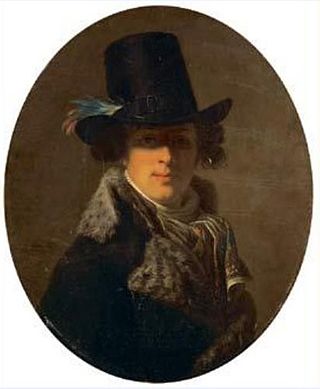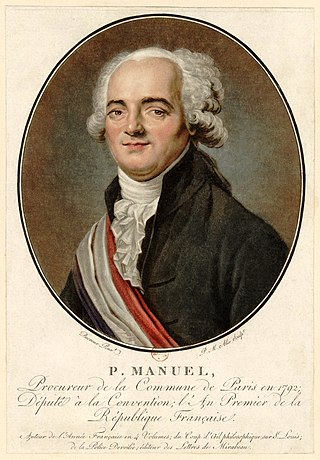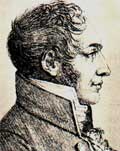
Gironde is the largest department in the Nouvelle-Aquitaine region of Southwestern France. Named after the Gironde estuary, a major waterway, its prefecture is Bordeaux. In 2019, it had a population of 1,623,749. The famous Bordeaux wine region is in Gironde. It has six arrondissements, making it one of the departments with the most arrondissements.

Charles Jean Marie Barbaroux was a Girondin politician of the Revolutionary period and Freemason. He was the leader of the Fédérés and popular in the South of France.

Jean-Lambert Tallien was a French politician of the revolutionary period. Though initially an active agent of the Reign of Terror, he eventually clashed with its leader, Maximilien Robespierre, and is best known as one of the key figures of the Thermidorian Reaction that led to the fall of Robespierre and the end of the Terror.

Louis Pierre Manuel was a republican French writer, municipal administrator of the police, and public prosecutor during the French Revolution who was arrested, trialled and guillotined.

Jean Marie Claude Alexandre Goujon was a politician of the French Revolution. He was a member of the National Convention from 1793 to 1795, was sentenced to death after the Revolt of 1 Prairial Year III and committed suicide before he could be executed.

Maximilien François Marie Isidore de Robespierre was a French lawyer and statesman, widely recognized as one of the most influential and controversial figures of the French Revolution. Robespierre fervently campaigned for the voting rights of all men and their unimpeded admission to the National Guard. Additionally he advocated for the right to petition, the right to bear arms in self-defence, and the abolition of the Atlantic slave trade. He was a radical Jacobin leader who came to prominence as a member of the Committee of Public Safety, an administrative body of the First French Republic. His legacy has been heavily influenced by his actual or perceived participation in repression of the Revolution's opponents, but is notable for his progressive views for the time.

Nicolas Marie Quinette, Baron de Rochemont was a French politician.

Jacques-Alexis Thuriot, known as Thuriot de la Rosière, and later as chevalier Thuriot de la Rosière, chevalier de l'Empire was an important French statesman of the French Revolution, and a minor figure under the French Empire of Napoleon Bonaparte.

Pierre Joseph Duhem was a French physician and politician.
Claude-Antoine-Auguste Blad, was a politician of the French revolutionary era.

Jean Bertrand Féraud, was a French politician of the French revolutionary era.
François Sébastien Christophe Delaporte,, , was a politician at the time of the French Revolution.
Laurent Lecointre was a French politician, born at Versailles on 1 February 1742, and died at Guignes, Seine-et-Marne on 4 August 1805. He is also known under the name of "Lecointre de Versailles".
Unlike the other legislatures of the Fifth French Republic, the eighth legislature from 1986 to 1988 had proportional representation by department. This table summarises representatives from Ain in the 7th, 8th and 9th legislatures.
Unlike the other legislatures of the Fifth French Republic, the eighth legislature from 1986 to 1988 had proportional representation by department.
Unlike the other legislatures of the Fifth French Republic, the eighth legislature from 1986 to 1988 had proportional representation by department.
Grégoire Marie Jagot was a French commissioner and justice of the peace in the times of French revolution.
Claude Demassieux is a French politician from Rally for the Republic, who served as a member of the National Assembly between 1993 and 1997, representing the Pas-de-Calais's 7th constituency.










